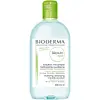What's inside
What's inside
 Key Ingredients
Key Ingredients

 Benefits
Benefits

 Concerns
Concerns

 Ingredients Side-by-side
Ingredients Side-by-side

Paraffinum Liquidum
EmollientEthylhexyl Palmitate
EmollientIsododecane
EmollientCaprylic/Capric Triglyceride
MaskingPEG-20 Glyceryl Triisostearate
EmollientC13-15 Alkane
SolventMacadamia Ternifolia Seed Oil
EmollientTocopheryl Acetate
AntioxidantPhenoxyethanol
PreservativeParfum
MaskingBisabolol
MaskingBHT
AntioxidantSalicylic Acid
MaskingWater
Skin ConditioningPropanediol
SolventGlycine Soja Oil
EmollientEthylhexylglycerin
Skin ConditioningPersea Gratissima Oil
Skin ConditioningSimmondsia Chinensis Seed Oil
EmollientIsobornyl Acetate
MaskingArtemisia Capillaris Flower Extract
Skin ConditioningCalendula Officinalis Flower Extract
MaskingChamomilla Recutita Flower Extract
MaskingFucus Vesiculosus Extract
EmollientTriticum Vulgare Bran Extract
Skin ConditioningLinoleic Acid
CleansingTocopherol
AntioxidantParaffinum Liquidum, Ethylhexyl Palmitate, Isododecane, Caprylic/Capric Triglyceride, PEG-20 Glyceryl Triisostearate, C13-15 Alkane, Macadamia Ternifolia Seed Oil, Tocopheryl Acetate, Phenoxyethanol, Parfum, Bisabolol, BHT, Salicylic Acid, Water, Propanediol, Glycine Soja Oil, Ethylhexylglycerin, Persea Gratissima Oil, Simmondsia Chinensis Seed Oil, Isobornyl Acetate, Artemisia Capillaris Flower Extract, Calendula Officinalis Flower Extract, Chamomilla Recutita Flower Extract, Fucus Vesiculosus Extract, Triticum Vulgare Bran Extract, Linoleic Acid, Tocopherol
 Reviews
Reviews

Ingredients Explained
These ingredients are found in both products.
Ingredients higher up in an ingredient list are typically present in a larger amount.
Parfum is a catch-all term for an ingredient or more that is used to give a scent to products.
Also called "fragrance", this ingredient can be a blend of hundreds of chemicals or plant oils. This means every product with "fragrance" or "parfum" in the ingredients list is a different mixture.
For instance, Habanolide is a proprietary trade name for a specific aroma chemical. When used as a fragrance ingredient in cosmetics, most aroma chemicals fall under the broad labeling category of “FRAGRANCE” or “PARFUM” according to EU and US regulations.
The term 'parfum' or 'fragrance' is not regulated in many countries. In many cases, it is up to the brand to define this term.
For instance, many brands choose to label themselves as "fragrance-free" because they are not using synthetic fragrances. However, their products may still contain ingredients such as essential oils that are considered a fragrance by INCI standards.
One example is Calendula flower extract. Calendula is an essential oil that still imparts a scent or 'fragrance'.
Depending on the blend, the ingredients in the mixture can cause allergies and sensitivities on the skin. Some ingredients that are known EU allergens include linalool and citronellol.
Parfum can also be used to mask or cover an unpleasant scent.
The bottom line is: not all fragrances/parfum/ingredients are created equally. If you are worried about fragrances, we recommend taking a closer look at an ingredient. And of course, we always recommend speaking with a professional.
Learn more about ParfumWater. It's the most common cosmetic ingredient of all. You'll usually see it at the top of ingredient lists, meaning that it makes up the largest part of the product.
So why is it so popular? Water most often acts as a solvent - this means that it helps dissolve other ingredients into the formulation.
You'll also recognize water as that liquid we all need to stay alive. If you see this, drink a glass of water. Stay hydrated!
Learn more about Water